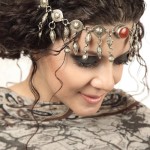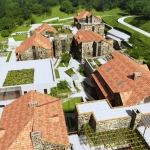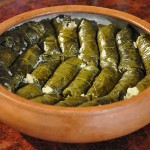The Ornament of Armenian Medieval Architecture
Early medieval Armenian architecture (4-7 centuries) has exclusive significance for the history of ecclesiastical architecture of Armenia. After adopting Christianity as the state religion in 301 a new stage of development begins with the introducing of new setup, new artistic and constructive principles that became the basis of the medieval Armenian architecture.
One of the masterpieces of that period is the temple of Odzun built on 6-7 centuries. The temple is situated in Odzun village of Lori region, on the high hill surrounded by wonderful northern nature of Armenia, the colorful images of which become more fantastic in autumn. The temple represents a domed basilica with a rectangular plan stretching from west to east which inside is divided into 3 halls by 3 pairs of pillars; the central hall is wider and ends in the main semicircle altar, and from the lateral ones the entrances to depositors are opened. The dome that is placed nearly in the middle of the porch dominates in the whole setup of the church.
From the north, west and south the temple is surrounded by parlors. The northern and southern ones are distinguished for the arcades, and the arched entrance of the church opens from the western parlor. The small bell-towers can be seen in the both sides of the eastern facade. The setup of the temple is filled up by the artistic expressive means of the monument. The facades are decorated by different bas-reliefs which present vegetative decoration patterns, encircled crosses, high-reliefs set in the walls one of which presents Our Lady with infant Christ in her lap. Some of these high-reliefs belong to the period of building the temple; the others are older and are supposed to have been transferred from other monuments. There is a tomb solemnly situated in the north-eastern side of the temple which is one of the best examples of the early medieval Armenian memorial architecture and sculpture.
There between 3 arched struts placed on a high pedestal stand two quadrilateral monuments of 5 meters height wholly decorated with highly artistic bas-reliefs of religious scenes with rich geometric and floral ornaments. One of them is very interesting; it portrays a man with a pig’s head holding in hand a cane crowned with a cross in the end. It is assumed that this image is related to the tradition connected with Armenian king Tiridates III according to which he has been transformed to a pig. The images of apostles and Our Lady with the child can also be seen in the bas-reliefs.










